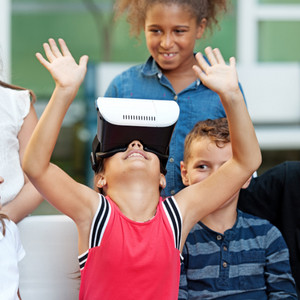Immersive Learning Resources for Classrooms
Immersive learning is a digital approach to education that addresses the issue of student interest and engagement. This digital learning technique makes use of simulated or artificial environments to create unique learning experiences for students.
Immersive learning, as the name suggests, allows students to engage in interactive digital environments. The programs use sounds, images, and other sensations to give students a full sensory experience, causing them to get an actual “feel” for the environment. Immersive learning techniques help students to experience, explore, and navigate real-world subjects and destinations within the comfort of their classrooms. Immersive learning can be great activity for a socially distant classroom since each student is immersed in their own individual world.
Immersive learning is commonly implemented in classrooms using methods such as:
- Virtual reality (VR): Virtual reality programs are digital simulations of the real world. Using VR headsets (Google Cardboard), students experience pre-designed virtual environments and explore them as teachers guide their learning.
- Augmented reality (AR): Augmented reality programs place virtual objects in real environments (for example, Pokemon Go), converting it into a digital interface.
- Mixed reality (MR): This is a combination of both virtual and augmented reality, placing virtual objects in a real-world background, making virtual interactions appear real. Mixed reality enables users to navigate through the real and virtual environments simultaneously.
- Gamification: Gamification is the process of applying game mechanics and designs to learning methods.
Here are some safety tips to bear in mind while implementing these immersive learning tools in the socially distant classroom:
- Use the tools in open spaces, as students might need to move around. Better yet, bring them outdoors for a safe, socially distant learning activity.
- Plan for short sessions as students may feel disoriented after use of headsets.
- Make sure the tools are properly sanitized before and after each use.
- Ensure that students can still wear masks when appropriate.
Why use Immersive Learning Resources?
Teachers can use immersive learning techniques to create a technology-assisted active learning process which helps students to:
- Gain knowledge through exploring and manipulating objects and environments.
- Learn at their own pace.
- Enhance their understanding of abstract concepts and their relationships by providing them with a context.
- Develop skills and apply learned concepts to challenging real-world problems and scenarios.
The use of virtual programs helps teachers to:
- Supplement lectures.
- Create a safe and controlled learning environment, which allows students to make and learn from mistakes.
- Present a lesson that is free from distractions.
- Facilitate the development of collaboration and team building skills.
Immersive learning resources for classrooms help students develop skills and maximize learning while engaging in enjoyable, relevant learning experiences. Immersive tools and strategies can make learning exciting for students, and clarify concepts that are best learned hands-on.
Immersive learning resources for classrooms are just one way to add fun and interactive technology into the curriculum. Check out more tech strategies with the online PD class: Apps for Education.
January 2021 Editor’s Note: This post was originally published in July 2015 and has been updated for accuracy and comprehensiveness.
 About the Author
About the Author
Ellen Paxton is a respected expert in education and best known as the Chief Learning Officer of Professional Learning Board. As a two-time National Board Certified Teacher, Ellen has successfully published and customized online professional development courses and Learning Management Systems for 20 years to help teachers meet their state continuing education renewal credit requirements. Through ProfessionalLearningBoard.com, RenewaTeachingLicense.com, and ConnectedPD.com, Ellen has established solutions and maintained partnerships with several accredited universities, higher education institutions, teachers’ unions and state Departments of Education while setting strategic direction that makes a difference and overseeing implementation of popular online PD for schools.

Comments are closed.